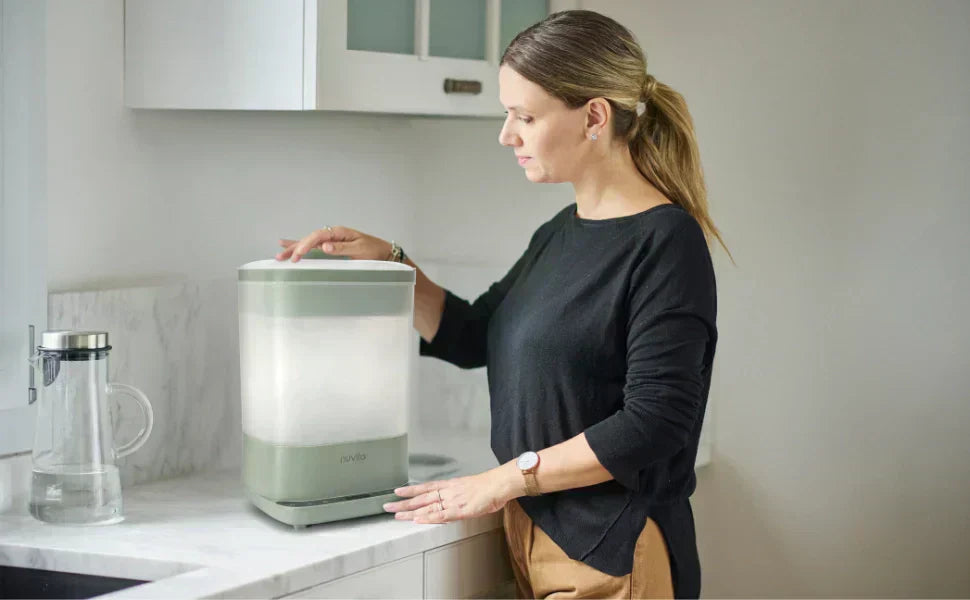How to properly sterilize baby bottles, pacifiers, and accessories

Protecting your baby from the very first days is essential, and the first few months of life are a special and delicate period because your little one is beginning to explore the world, but their immune system is still immature and vulnerable.
To protect them from invisible risks like bacteria, viruses, and fungi, it's important to adopt simple daily habits, including the proper sterilization of bottles, pacifiers, and accessories. Learn how to choose the best sterilization method for bottles, pacifiers, and accessories, understand the importance of sterile drying, and know how long these good practices are recommended to safeguard your baby's health.
During the first six months of a newborn's life, it's recommended to sterilize daily all items that come into contact with the mouth or milk, such as bottles, nipples, and breast pump parts. Even if an item looks clean, it may still harbor invisible microorganisms that pose a health risk. Consistent sterilization is key to minimizing infection risk, especially in the early months, although an occasional oversight should not cause panic.
The risks of incomplete or absent sterilization
Poor or no sterilization can increase the risk of:
- Bacterial gastroenteritis (Escherichia Coli, Salmonella)
- Fungal infections (Candida albicans)
- Respiratory infections
- Alteration of gut microbiota
- Cross-contamination from resistant bacteria.
According to the Italian Society of Neonatology and the WHO, proper sterilization of baby accessories significantly reduces these risks. Among the most effective methods, steam and UV-C sterilization are considered the best. The choice depends on the type of item being sterilized and the practicality desired in daily management.
After the first six months, when the baby starts eating solid foods and strengthening their immune system, the frequency of sterilization can be gradually reduced, while still maintaining good hygiene for main accessories at least until 12 months or longer, especially in cases of illness or special medical conditions.
Items that require the most attention in sterilization
In the early months, it's important to regularly sterilize:
- Bottles and nipples
- Pacifiers
- Breast pump parts
- Containers for storing breast milk
- Teething rings
- Baby utensils and cups
- Chewable toys
These items come into direct contact with the mouth or breast milk and can become vehicles for infections if not sterilized properly.

Main sterilization methods
Many parents choose to rely on a practical and safe sterilizer for daily hygiene of bottles, pacifiers, and accessories.
Boiling water sterilization: involves immersing items in boiling water for at least 10 minutes. It's a simple and effective method, though less convenient long term.
Steam sterilization: uses high-temperature steam to kill germs and bacteria within minutes. It can be done using electric devices or microwaves.
UV-C sterilization: uses ultraviolet light to deactivate viruses, bacteria, and mold—ideal for heat-sensitive items.
Cold chemical sterilization: uses disinfectant solutions and is only recommended in emergencies due to the risk of chemical residue.
The importance of sterile drying
After sterilization, drying is essential to prevent recontamination: if you don’t have a sterilizer with a drying function, it’s important to dry items on a clean surface, preferably protected with a sterilized cloth or disposable paper, avoiding contact with unwashed hands or contaminated surfaces.
This reduces the risk of secondary contamination, but it’s important to know that the effectiveness of sterilization is only partially maintained, around 70–75%. Using a sterilizer with a drying function equipped with a HEPA filter, such as the Nuvita SteriDry 1088 , allows for drying in a sterile environment, eliminating 99.97% of contaminant particles. According to data confirmed by the EPA (Environmental Protection Agency, the United States agency that sets internationally recognized standards for air quality and HEPA filter effectiveness), sterilization effectiveness can be maintained up to 99.9% with the device closed.

Until what age is sterilization recommended?
According to recommendations from the Italian Pediatric Society, it is especially important to sterilize from birth up to about 6 months of age.
Later on, as the baby develops a more mature gut microbiota through weaning and exposure to new environments, the need for sterilization decreases. However, it's still advisable to maintain thorough hygiene for bottles, pacifiers, and breast pumps at least until 12 months or longer in case of special medical conditions or premature birth.
Every parent wants the best for their little one; establishing a proper sterilization and sterile drying routine is not just a practical choice but a daily act that helps protect health and supports safe and healthy development.
There are various sterilizers designed to simplify parents’ lives depending on their needs: from high-tech models to classic steam sterilizers, microwave-compatible ones, and portable UV models that are convenient for on-the-go. A full overview of all options is available on our website in the sterilizers section to help choose the one that best fits each family’s lifestyle and feel confident at all times.





